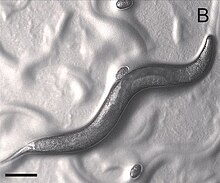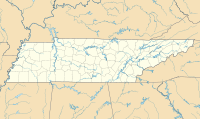디플로가스테루스과
Diplogasteridae| 디플로가스테루스과 시간 범위: | |
|---|---|
 | |
| 과학적 분류 | |
| 왕국: | 애니멀리아 |
| 문: | 선충류 |
| 클래스: | 크로마도레아목 |
| 주문: | 라브디티다 |
| 인프라스트럭처: | 디플로가스테로모파스 |
| 슈퍼 패밀리: | 디플로게스테로아과 |
| 패밀리: | 디플로가스테루스과 미콜레츠키 1922 |
| 속 | |
| 텍스트 참조 | |
| 동의어 | |
Diplogastridae(이전의 Diplogasteridae)는 다양한 서식지에서 알려져 있는 선충과(회충과)로 곤충과의 [1]공통 또는 기생 관계에 있다.
묘사
디플로가스트리드 선충은 뚜렷한 "두 개의 갈라진" 인두(그리스어 δλςςςς = "double" 및 σα "ρ " " "stomach = "double"에서 유래한 이름)를 가지고 있으며, 두 번째(대부분) 엽은 선상 조직으로 구성되어 있다.대부분의 알려진 종들은 또한 적어도 하나의 이빨을 가지고 있는데, 이것은 아마도 박테리아를 먹고 사는 대부분의 종인 Rhabditidae와 관련된 선충들과 비교하여 그들이 많은 새로운 음식 자원에 접근할 수 있게 해 주었다.몇몇 디플로가스트리드 종들은 또한 그들의 입 부분에 폴리페니즘을 가지고 있어서 종 내에서 자원 분화를 가능하게 한다.Diplogastridae의 광범위한 섭식 모드는 Rhabditidae에 [2]비해 진화의 속도가 빨라진 구강 구조의 비교적 높은 다양성과 복잡성에 의해 반영된다.
수드하우스와 리벤은 개정안의 일괄 접근에서 많은 총칭들을 가라앉혔지만, 헝가리의 선충학자 이스트반 안드라시는 많은 선충 분류군을 [4]세우고 다시 세운 "분열자"였다.라그스데일과 다른 사람들의 접근법이 최근 몇 [5]년 동안 보여주었듯이 진실은 그 중간 어딘가에 있을지도 모른다.
Diplogastridae에는 비교발달생물학의 모델 생물인 선충(Pristionchus pacificus)이 있다.
속
- 아크로스티쿠스
- 동종 증배자
- 앵커디플로거스터
- 버틀러리우스
- 두족류
- 큐티플로거스터
- 데마니엘라
- 디플로가스터
- 디플로가스테리아나
- 디플로게스테로이데스
- 디플로가스트렐루스
- 픽처
- ② 포미코드로거스터(화석, 도미니카[6] 황색)
- 고파르티아
- 헤테로플루론종
- 후고트디플로거스터
- 케르네리아
- 렙토야코부스
- 레비팔라툼
- 롱기부카
- 메히디네마
- 미콜레츠키아
- 모노코이데스
- 오이골라이멜라
- 네오디플로그스터
- 파라프리스티온쿠스
- 기생충 증배자
- 파로이골라이멜라
- 프리스티온쿠스
- 유사 증배 가스테로이데스
- 라브디티도이데스
- 라브디톨라이무스
- 삭시아
- 수드하우스
- 테라토다프로가스터
- 늑인두
레퍼런스
- ^ Sudhaus, W.; Fürst von Lieven, A. (2003). "A phylogenetic classification and catalogue of the Diplogastridae (Secernentea, Nematoda)". Journal of Nematode Morphology and Systematics. 6: 43–90.
- ^ Susoy, V.; Ragsdale, E.J.; Kanzaki, N.; Sommer, R.J. (2015). "Rapid diversification associated with a macroevolutionary pulse of developmental plasticity". eLife. 4: e05463. doi:10.7554/eLife.05463. PMC 4357287. PMID 25650739.
- ^ Sudhaus, W.; Fürst von Lieven, A. (2003). "A phylogenetic classification and catalogue of the Diplogastridae (Secernentea, Nematoda)". Journal of Nematode Morphology and Systematics. 6: 43–90.
- ^ Andrassy I (2005). "free-living nematodes of Hungary (Nematoda, Errantia) Vol 1". Pedozoologica Hungarica Nr.3.
- ^ Kanzaki N, Ragsdale EJ, Giblin-Davis RM (2014). "Revision of the paraphyletic genus Koerneria Meyl, 1960 and resurrection of two other genera of Diplogastridae (Nematoda)". ZooKeys (442): 17–30. doi:10.3897/zookeys.442.7459. PMC 4205494. PMID 25349487.
- ^ Poinar, G.O. (2011). "The Evolutionary History of Nematodes: As Revealed in Stone, Amber and Mummies". Nematology Monographs and Perspectives Pages. 9: 91–93, 239–240, 324–325.



